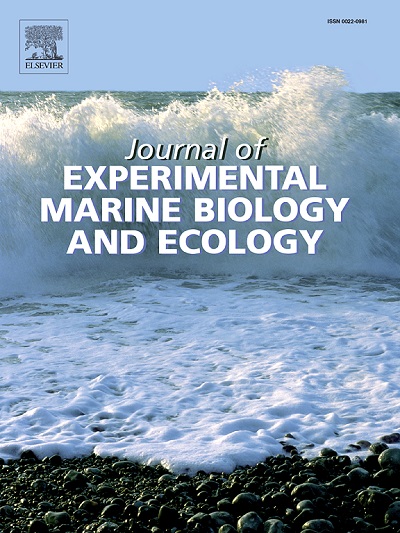Effects of season, size, and sex on tolerance of a simulated cold snap in latitudinally separated populations of the poleward-invading green porcelain crab (Petrolisthes armatus)
IF 1.8
3区 生物学
Q3 ECOLOGY
Journal of Experimental Marine Biology and Ecology
Pub Date : 2024-10-11
DOI:10.1016/j.jembe.2024.152063
引用次数: 0
Abstract
Poleward range expansion in the green porcelain crab Petrolisthes armatus is thought to be associated with rising coastal water temperatures along the southern Atlantic Bight. Periods of anomalous cold temperature (“cold snaps”), however, could delay or limit further expansion, especially if northern populations are unable to adjust cold tolerance through adaptation or acclimation. We tested cold tolerance in crabs from four latitudes, from Savannah, GA to North Inlet, SC, along the species' poleward invasion front. Laboratory incubation trials were conducted in multiple seasons using adult, non-ovigerous P. armatus to compare cold temperature thresholds between populations, sexes, and sizes. These trials recorded temperature thresholds for induction of both sublethal (loss of righting response) and lethal effects. Following acclimation, crabs were exposed to a rapid (1 °C d−1) temperature drop, modeled after water temperatures recorded during a severe winter cold snap in Charleston Harbor, SC. Crabs generally experienced mobility loss below 8 °C and mortality below 4 °C. In trials at the end of fall, crabs from the two more northern populations survived significantly longer, consistent with latitudinal differences in temperature as crabs prepared physiologically for winter. At the end of summer, crabs from the northernmost population showed greater cold resilience in both lethal and sublethal measures. At the end of spring, when animals are reproductive, there were mixed results with regard to a latitudinal pattern. When differences between sexes and sizes were significant, females were less susceptible than males and, in all but one case, smaller individuals were less susceptible than larger. In general, crabs at the start of winter maintained mobility and survived longer in the cold snap than they did when tested in the other two seasons. Although cold snaps may reduce population sizes of P. armatus, increased cold tolerance of more poleward populations could help to facilitate range expansion, especially if increasingly mild winter conditions move their thermal barrier toward higher latitudes.
季节、大小和性别对纬度分离的极地入侵绿瓷蟹(Petrolisthes armatus)种群耐受模拟寒流的影响
据认为,青瓷蟹向极地扩展的范围与大西洋南岸沿海水温上升有关。然而,异常低温期("寒流")可能会延迟或限制进一步的扩张,尤其是如果北方种群无法通过适应或驯化来调整耐寒性。我们测试了从佐治亚州萨凡纳到南卡罗来纳州北英莱特四个纬度的螃蟹对寒冷的耐受性,这些螃蟹来自该物种向极地入侵的前沿。我们在多个季节使用成年、不发情的绒螯蟹进行了实验室孵化试验,以比较不同种群、性别和大小的绒螯蟹的低温阈值。这些试验记录了诱导亚致死效应(丧失右旋反应)和致死效应的温度阈值。在适应之后,螃蟹暴露于快速(1 °C/d-1)的温度下降中,该温度是以南卡罗来纳州查尔斯顿港冬季严寒期间记录的水温为模型的。螃蟹在温度低于8 °C时普遍丧失活动能力,在温度低于4 °C时死亡。在秋末的试验中,来自两个较北种群的螃蟹存活时间明显较长,这与纬度上的温度差异是一致的,因为螃蟹在生理上做好了过冬的准备。在夏末,来自最北部种群的河蟹在致死和亚致死试验中都表现出更强的抗寒能力。春末是螃蟹的繁殖期,纬度模式的结果不一。在性别和体型差异显著的情况下,雌性个体比雄性个体更不容易受到影响,而且除一种情况外,其他所有情况下,体型较小的个体比体型较大的个体更不容易受到影响。一般来说,与在其他两个季节进行的测试相比,冬季开始时的螃蟹在寒流中保持了活动能力,存活时间更长。虽然寒流可能会减少绒螯蟹的种群数量,但越靠前的种群耐寒能力越强,这有助于促进其分布范围的扩大,尤其是当冬季条件越来越温和时,它们的热屏障会向更高纬度移动。
本文章由计算机程序翻译,如有差异,请以英文原文为准。
求助全文
约1分钟内获得全文
求助全文
来源期刊
CiteScore
4.30
自引率
0.00%
发文量
98
审稿时长
14 weeks
期刊介绍:
The Journal of Experimental Marine Biology and Ecology provides a forum for experimental ecological research on marine organisms in relation to their environment. Topic areas include studies that focus on biochemistry, physiology, behavior, genetics, and ecological theory. The main emphasis of the Journal lies in hypothesis driven experimental work, both from the laboratory and the field. Natural experiments or descriptive studies that elucidate fundamental ecological processes are welcome. Submissions should have a broad ecological framework beyond the specific study organism or geographic region.
Short communications that highlight emerging issues and exciting discoveries within five printed pages will receive a rapid turnaround. Papers describing important new analytical, computational, experimental and theoretical techniques and methods are encouraged and will be highlighted as Methodological Advances. We welcome proposals for Review Papers synthesizing a specific field within marine ecology. Finally, the journal aims to publish Special Issues at regular intervals synthesizing a particular field of marine science. All printed papers undergo a peer review process before being accepted and will receive a first decision within three months.

 求助内容:
求助内容: 应助结果提醒方式:
应助结果提醒方式:


